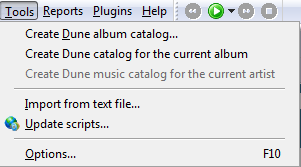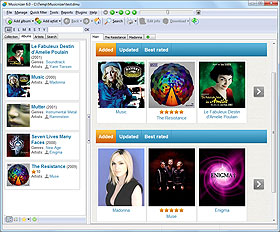Program Settings
Musicnizer is a very powerful music organizer, which also means that many settings can be customized. While it is possible to use the program for years without ever opening its "Options" menu, you may find that Musicnizer can be much more attractive if you adjust its behavior to your own needs.
Click "Tools" - "Options" or press F10:

This will open the "Options" menu window.

We can see that the window contains several tabs. On the screenshot above, the default, "General" tab is shown. We will discuss its options here. The "User interface" tab allows you to choose a visual style for the program. "Download options" are discussed in another section. "Scripts for albums" and "Scripts for artists" are used when downloading information about albums and artists. The "Custom fields" tab lets you adjust names and values of custom fields and lists. On the "Play options" tab you can choose whether to play your audio files with the built-in or with an external player.
Now let's take a closer look at the options represented on the "General" tab.
- Number of symbols in the synopsis. When a review of the album is available, the program will display only 500 first characters of the review on the album's page and in the reports. You can change this value to show more or fewer characters.
- Records per search page. This field defines how many records should be displayed on a single page when generating search results. 20 is default. You can change it to 0 in order to display all search results on a single page, but if there are too many items that match your search criteria, it may take quite some time to build such a page.
- Automatically add album to collection when downloading info. This will set the "In collection" flag for albums, if you download information about them. You may not always want to set this flag in such a situation: for example, you may just want to learn more about some album, but you do not have it in your collection yet.
- Automatically set return when changing album's location. This refers to the loan manager. If you set some album as loaned, but at some point later change its locations (for example, from the edit info dialog), the program will mark the album as returned.
- Auto filter when typing into quick search. The album list can be filtered automatically, as you type letters into the quick search box. If this leads to delays on your computer (for example, with a huge collection on a slow computer), you can disable the option. The list will be filtered only after you click "OK" or press "Enter".
- Show preview of the album/artist on mouse over. This displays a hint with some basic information about the album or artist on mouse over.
- Show nice preview. This defines whether to apply styles to the main album/artist lists. Without applying styles, the lists will work faster but look not that nice.
- Show the list of skipped albums. If you add many albums at once and use the "Automatically select the first album from search results" option, the program may fail to find information for some albums. In such case it will skip the albums. A list of skipped albums will be shown at the end of the process, if this option is enabled.
- Prompt to create a backup copy of the database every X days. Here you can define how often the program should prompt you to create a backup copy. It is recommended to back up your database after massive album updates and keep at least 3 latest backups.
- Refresh the collection when adding/removing. This will rebuild the collection list after you add or remove albums.
- Resizing pictures. Here you can choose whether to show the original size of pictures or to resize them to certain width. Both methods have their own advantages and disadvantages: for example, if not resizing, the picture viewer will "jump" on your screen showing pictures of different sizes.
The rest three options define how the program should act when scanning audio files.
